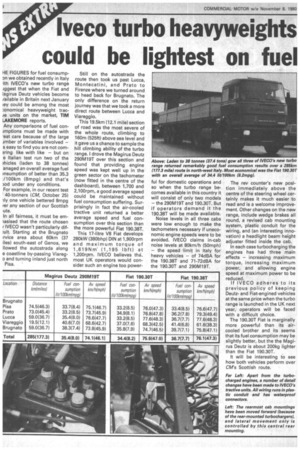New turbo heavyweights could be lightest on fuel
Page 30

If you've noticed an error in this article please click here to report it so we can fix it.
HE FIGURES for fuel consumpan we obtained recently in Italy ith IVECO's new turbo range iggest that when the Fiat and lagirus Deutz vehicles become tailable in Britain next January ley could be among the most onomical heavyweight tracre units on the market, TIM LAKEMORE reports.
Any comparisons of fuel conJrnptions must be made with .eat care because of the large imber of variables involved — s easy to find you are not corn]ring like with like — but on
e Italian test run two of the )hicles (laden to 38 tonnes) anaged an overall average fuel msumption of better than 35.3 /100km (8mpg) and that's )od under any conditions. For example, in our recent test 40-tanners (CM, October 25) Ily one vehicle bettered 8mpg fer any section of our Scottish ute.
In all fairness, it must be emiasised that the route chosen IVECO wasn't particularly dif:ult. Starting at the Brugnato Tvice area about 60km (37 iles) south-east of Genoa, we 'lowed the autostrada along e coastline by-passing Viarego and turning inland just north Pisa. Still on the autostrada the route then took us past Lucca, Montecatini, and Prato to Firenze where we turned around to head back for Brugnato. The only difference on the return journey was that we took a more direct route between Lucca and Viareggio.
This 19.5km (12.1 mile) section of road was the most severe of the whole route, climbing to 160m (525ft) above sea level and it gave us a chance to sample the hill climbing ability of the turbo range. I drove the Magi rus Deutz 290M19T over this section and found that providing engine speed was kept well up in the green sector on the tachometer (now fitted in the centre of the dashboard), between 1,700 and 2,100rpm, a good average speed could be maintained without fuel consumption suffering. Surprisingly in fact the air-cooled tractive unit returned a better average speed and fuel consumption over this section than the more powerful Fiat 190.38T.
This 17-litre V8 Fiat develops 280kW (380bhp) DIN at 1,900rpm and maximum torque of 1,619Nm• (1,195 lbft) at 1,200rprn. IVECO believes the. most UK operators would consider such an engine too power ful for domestic operations and so when the turbo range becomes available in this country it will consist of only two models — the 290M19T and 190.30T. But if operators demand it the 190.38T will be made available.
Noise levels in all three cabs were low enough to make the tachometers necessary if uneconomic engine speeds were to be avoided. IVECO claims in-cab noise levels at 80km/h (50mph) — the speed limit in Italy for heavy vehicles — of 74dBA for the 190.38T and 71-72dBA for the 190.30T and 290M19T. The rev counter's new position immediately above the centre of the steering wheel certainly makes it much easier to read and is a welcome improvement. Other changes on the new range, include wedge brakes all round, a revised cab mounting system, plastic conduit for the wiring, and (an interesting innovation) a headlight beam height adjuster fitted inside the cab.
In each case turbocharging the engines has had three main effects — increasing maximum torque, increasing maximum power, and allowing engine speed at maximum power to be reduced.
If IVECO adheres to its previous policy of keeping Deutzand Fiat-engined vehicles at the same price when the turbo range is launched in the UK next year, operators will be faced with a difficult choice.
The 190.30T Fiat is marginally more powerful than its aircooled brother and its seems that its fuel consumption may be slightly better, but the the Magirus Deutz is about 200kg lighter than the Fiat 190.30T.
It will be interesting to see how both vehicles perform over CM's Scottish route.




















































































































